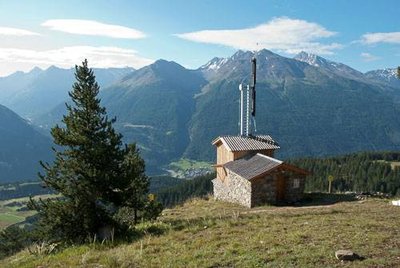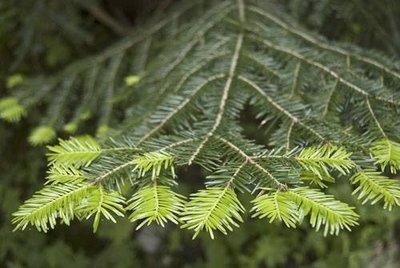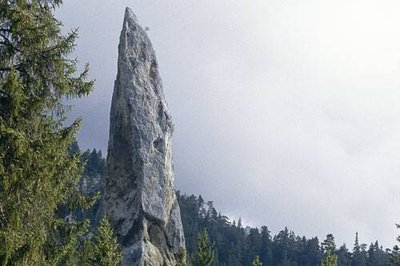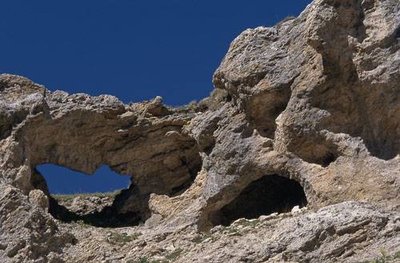
Between the monolith of Sardières and the Chappe telegraph
The scent of pine and the pale-coloured rock are evocative of the South, so much that one could almost hear the guitar of Nino Ferrer. Here the Maurienne marks the place of transition between the Northern Alps and those of the South. A walk in these adret forests is soothing, almost surprising, when the Monolith suddenly rises at the corner of a bend, leaving nothing but vertical drops. A lunch break at the Chappe telegraph invites the observer to fly over the multitude of peaks at more than 3,000 m forming the border chain with Italy. Perhaps you will spare a thought for those men charged with operating the telegraph who were stationed in this place, for days, scanning the horizon, like Giovanni Drogo awaiting the enemy in “The desert of the Tartars”.
Forecast
Altimetric profile
Recommandations
This hike stays within the mid-mountain. The route is marked but some sections are not on the IGN map. Take appropriate footwear. The viewpoint from the Chappe telegraph overlooks the unsecured cliffs. The route enters the heart of the protected area.
Information desks
Maison de la Vanoise, Place de la Vanoise, Termignon, 73500 Val-Cenis
Maison Cantonale, 9 Place Sommeiller, 73500 Modane
Access and parking
At Modane, take the D 215 in the direction of Aussois. Once at Aussois, cross the village towards Sardières. After one kilometre, park in the car park with a cross and information signs.
Parking :
10 points of interest

Aiguilles et cônes de pin à crochets. - PNV - BALAIS Christian  Flora
FloraThe mountain pine
The trail you go up crosses the old meadows now colonised by conifers, especially the mountain pine. This pine (Pinus uncinata) takes its name from its cones which carry hooks on the scales. Its dark green needles are joined together in pairs and measure 4 to 8 cm. The mountain pine favours the dry, steep slopes. Ÿou may confuse it with the Scots pine that you will also find along your way.
Résultat des avalanches des Balmes sur la forêt. - PNV - LACOSSE Pierre  Geology
GeologyAvalanche paths of the Balmes
Ÿou will notice in front of you the vast paths free of any vegetation or trees. These valleys, called Balmes, are highly susceptible to avalanches due to their inclination and orientation. The snow slides prevent the vegetation from colonising these areas. Ÿou may notice under the track to the east a multitude of trees, lying and broken. These are the stigmas of a large-scale avalanche that fell during the winter of 2012.
Le télégraphe Chappe restauré (Sollières Sardières). - PNV - BEURIER Mathieu  History
HistoryA Natura 2000 site
"A 1992 European directive called the “Habitat Directive” concerns the protection of particular natural environments and certain species of fauna and flora. The forest of the southern slopes of Haute-Maurienne has been classified as a special conservation area known as ""Natura 2000"" under the ""forest and herbaceous formations of the internal Alps""."
Au 1er pl. : le télégraphe Chappe restauré (Sollières Sardières). - PNV - BEURIER Mathieu  Architecture
ArchitectureChappe telegraph
The Chappe telegraph is an optical signal transmission system created in 1793. Napoleon I decided to use the process between Lyon and Milan. Telegraphs were then installed along the valley of Maurienne. The telegraph only worked from 1807 to 1814, as Savoy was attached to the Kingdom of Sardinia.
Jeunes pousses de l'année sur un rameau de sapin pectiné. (PNV PO) - PNV - DELORME Michaël  Flora
FloraThe fir tree
The European silver fir (Abies alba) is quite rare in the forests of the southern slope (known as the adret) of Haute-Maurienne. The fir tree, however, finds the conditions are favourable for its growth in the small, fresh and damp valley that you cross. The rest of the forest around the Monolith is almost entirely composed of pines and spruces. The fir can be identified by its needles, which seem to grow flat along the branch. If you turn them over you will see two white marks. The bark is a smooth, silver grey. The fir cones grow upwards, unlike those of its cousin, the spruce.
Face SO du Monolithe de Sardières. Commune de Sollières Sardières. - PNV - IMBERDIS Ludovic  Geology
GeologyThe Monolithe de Sardières
Erosion has made way for this cargneule needle over time. There are many similar formation peaks in the surrounding forest but this one is the most spectacular. The Monolithe de Sardières looms over you at 93 metres high. This target which is coveted by climbing enthusiasts was climbed for the first time in 1957 by Michel Paquier. Several paths of varying difficulty today criss-cross its faces. The Monolithe de Sardières is in the heart of Vanoise National Park. It was at the foot of this natural obelisk that the Park was inaugurated on 26th June 1965.
Cargneules. - PNV - FOLLIET Patrick  Geology
GeologyCargneule
The cargneule, a carbonate sedimentary rock, with a decayed and frequently brecciated appearance, often takes on yellow, brown or rusty hues. The cargneules form lightly stratified or unstratified masses and give ruiniform reliefs. Ÿou can see these towers before you, evocative of ancient castle ruins. The transformation of dolomite or limestone into calcite by waters loaded with calcium as a result of the dissolution of gypsum is called cargneulisation. (CaSO4 → Ca2+ + SO4-2).
Chouette de Tengmalm. - PNV - JALABERT Didier  Fauna
FaunaThe Tengmalm's owl
The boreal or Tengmalm´s owl (Aegolius funereus) is a small owl inhabiting the coniferous forests. It feeds mainly on small rodents and is essentially nocturnal. Its territorial song is a series of melancholic “pou pou” calls. The song of the Tengmalm´s owl echœs once again in the French forests thanks to the return of the black woodpecker. The black woodpecker bores holes in tree trunks and the owl loves these cavities to nest.
Cerf élaphe : mâle adulte dans une clairière pendant la période du brame. - PNV - PLOYER Jean-Yves  Fauna
FaunaThe deer
As a result of hunting and logging, the deer had all but disappeared from the Savoy forests. Reintroduced between 1958 and 1973, it has adapted remarkably well to the mountain environment to form a fine population. In autumn the mating season, called “the roar” gives rise to spectacular fighting between males, but it is the raucous and powerful cries of the deer that bring the valley to life. The female deer, the hind, generally lives in a family group comprising the fawns born in the most recent year and the previous year´s generation.
Prairies fleuries au Plan de la Croix, Aussois. Au fd., le val d'Ambin. - PNV - BEURIER Mathieu  Pastoralism
PastoralismThe hay meadows
Ÿou are now crossing the Plan de la Croix. These flat areas are rare in the mountains and have always been used by the mountain people to harvest hay. These hay meadows are a remarkable habitat for a number of birds that breed only in these areas where large flowers and tall grasses grow. Attune your ears and you may hear the typical singing of the quail, whose mnemotechnical onomatopœia could be “wet-my-lips”. Traditional agricultural practices allow the presence of a large number of flora species, unlike areas of intensive agriculture. The excessive soil improver that enriches the grasslands with nutrients reduces the number of species present. There is now a contest for the best flowering meadows which aims to reward these traditional practices: the meadows of Plan de la Croix have been the winners of this contest.
